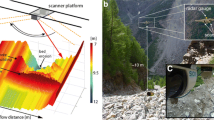Abstract
Travel times for wet volcanic mass flows (debris avalanches and lahars) can be forecast as a function of distance from source when the approximate flow rate (peak discharge near the source) can be estimated beforehand. The near-source flow rate is primarily a function of initial flow volume, which should be possible to estimate to an order of magnitude on the basis of geologic, geomorphic, and hydrologic factors at a particular volcano. Least-squares best fits to plots of flow-front travel time as a function of distance from source provide predictive second-degree polynomial equations with high coefficients of determination for four broad size classes of flow based on near-source flow rate: extremely large flows (>1 000 000 m3/s), very large flows (10 000–1 000 000 m3/s), large flows (1000–10 000 m3/s), and moderate flows (100–1000 m3/s). A strong nonlinear correlation that exists between initial total flow volume and flow rate for "instantaneously" generated debris flows can be used to estimate near-source flow rates in advance. Differences in geomorphic controlling factors among different flows in the data sets have relatively little effect on the strong nonlinear correlations between travel time and distance from source. Differences in flow type may be important, especially for extremely large flows, but this could not be evaluated here. At a given distance away from a volcano, travel times can vary by approximately an order of magnitude depending on flow rate. The method can provide emergency-management officials a means for estimating time windows for evacuation of communities located in hazard zones downstream from potentially hazardous volcanoes.
Similar content being viewed by others
Author information
Authors and Affiliations
Corresponding author
Additional information
Received: 5 June 1997 / Accepted: 2 February 1998
Rights and permissions
About this article
Cite this article
Pierson, T. An empirical method for estimating travel times for wet volcanic mass flows. Bull Volcanol 60, 98–109 (1998). https://doi.org/10.1007/s004450050219
Published:
Issue Date:
DOI: https://doi.org/10.1007/s004450050219




